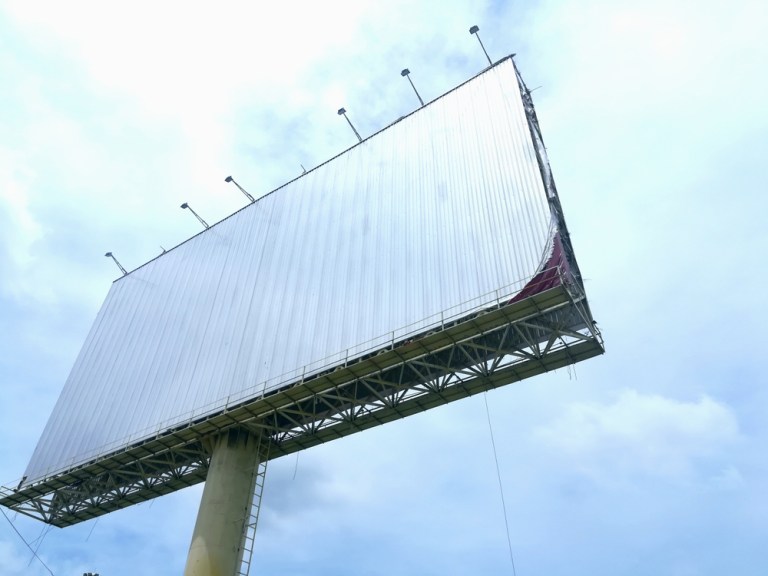Don’t Count Out Billboards — Amazon, Facebook And Google Haven’t

Billboards are not going gently into that good night. In fact, the old-fashioned form of outdoor advertising is winning over digital marketing heavyweights and finding ways to thrive in the online world. Examples abound.
Amid data sharing and online privacy controversies, Facebook recently promoted on billboards what Bloomberg called the social media operator’s “new approach to user safety and privacy.” Spotify turned to subway advertising — miniature billboards, so to speak — to entice customers to download a free version of the music streaming company’s app, a promotion tied to a David Bowie museum exhibit in New York City. Chip maker Intel, meanwhile, has used billboards to market artificial intelligence (AI).
Billboard Growth
Out-of-home (OOH) advertising, in fact, depends on digital players for much of its current success, according to the Outdoor Advertising Association of America (OAAA).
In 2017, the top 10 spenders on out-of-home advertising — a category that includes not only traditional billboards, but bus wraps, digital displays, cinema ads and other marketing messages seen outside consumers’ homes — were: McDonald’s, Apple, GEICO, American Express, Google, Amazon, Coca-Cola, HBO, Verizon and Chevrolet. McDonald’s and Apple also held the top two spots in 2016. Not far behind the top 10, Netflix ranks as one of the top 15 spenders.
That’s not all: “Of the top 100 OOH advertisers in 2017, almost one-quarter were from the technology sector,” the OAAA said.
Overall, out-of-home advertising increased 1.2 percent year over year in 2017 when measured by revenue, reaching $7.7 billion. That is lower than the 3.1 percent year-over-year growth rate in 2016 or the 4.6 percent growth rate in 2015. Despite that decline, as of the end of 2017, OOH advertising had experienced 31 consecutive quarters of growth since the recession.
By contrast, digital ad spending in the United States will reach $107.3 billion this year, up nearly 19 percent year over year, according to an eMarketer projection. Google and Facebook combined will take in nearly 28 percent of that digital ad spend in 2018. Mobile, meanwhile, will account for about 70 percent of all digital ad spending this year, driven by display ads. Those digital numbers don’t negate the importance of tech and digital marketing service providers to the financial health of out-of-home advertising, such as billboards.
“OOH continues to set record revenues in an age of unprecedented levels of digital ad spend,” said OAAA President and CEO Nancy Fletcher. “OOH is growing because it complements digital media by priming search, mobile and social engagement.”
OOH Development
Billboards used to be hand-painted, but those days have given way to digital displays that can rotate every 10 seconds or so — and to experimental forms that combine ridesharing with advertising, which cover the exterior of a car, as is the case for WaiveCar and described in a PYMNTS interview with the company’s founder.
However, digital companies that get creative and craft interesting partnerships around outdoor advertising campaigns seem likely to find more success than firms that don’t do this, at least according to the Bloomberg report on Monday (Aug. 6). Spotify based its campaign around a David Bowie exhibit at the Brooklyn Museum and, according to a Spotify executive, the company was “stunned by the number of social media shares that the Bowie campaign racked up.”
“If you do any outdoor campaign in a unique and creative way, all the people connected on their mobile phones will want to share it on social media,” said Alex Bodman, Spotify’s global executive creative director, to Bloomberg. “Outdoor advertising can become social media.”
Digital technology is helping the outdoor advertising industry attract more digital dollars. Mobile data from third-party providers — a practice that has attracted recent criticism — has reportedly helped outdoor advertising providers “to detect which phones pass in front of its billboards. That’s helping to make the case that physical ads in public spaces still work.”
Some of the appeal of billboards and outdoor advertising comes down to a fact of human nature, according to observers: People respond to messages they can see, and perhaps even touch in the physical world. The tangible retains an important position in the wiring of our brains. If so, that could further extend the financial health of an advertising form that seems decidedly unhip in this world of digital and mobile.